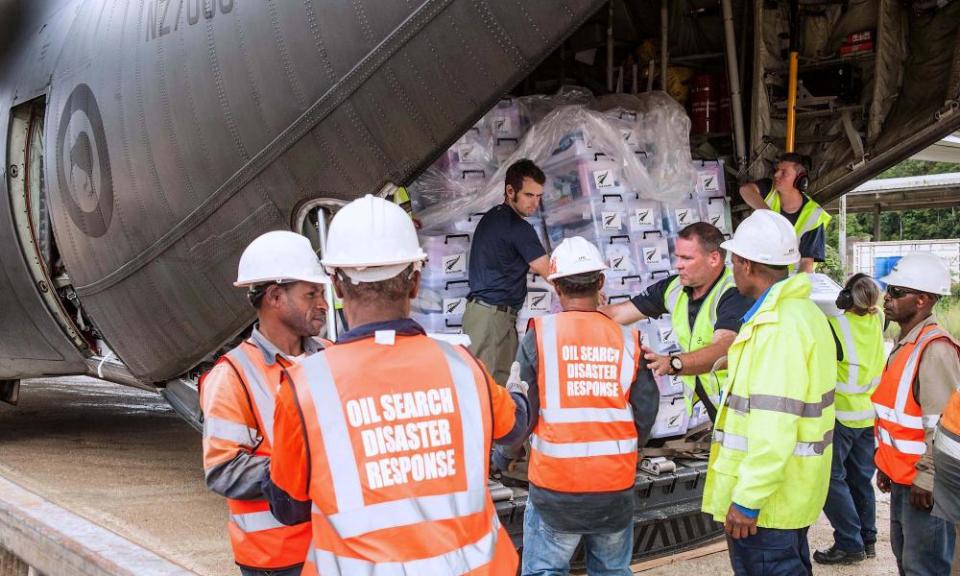Papua New Guinea earthquake: death toll rises as disease threat grows

The official death toll following Papua New Guinea’s 7.5 magnitude earthquake has risen to 145 but still has further to climb, officials have said.
Almost three weeks after the earthquake struck the provinces of Hela and Southern Highlands, some places remain cut off and an estimated 35,000 people have been displaced, the PNG police force said on Wednesday.
“From the reports received at the command centres [in Tari and Mendi], 45 have died so far in the Southern Highlands province and in Hela 80 people are confirmed dead,” a spokesman said.
“It is expected that the figure might increase once all people have been accounted for.”
About 270,000 people, including 125,000 children, require urgent humanitarian assistance, Unicef has said.

Aftershocks are continuing in some areas and people will not return to their homes and mountainside crops for fear of further landslides, according to NGOs on the ground.
“We’re still getting aftershocks; we had one last night,” said Andreas Wuestenberg from the village of Pimiga, where people had moved to an emergency camp.
“[Food] stocks are rapidly depleting. We’re not yet seeing a high increase in malnutrition in children but we’re expecting that will rise quite quickly.
“One of the main concerns is also the spread of disease, especially in this makeshift camp.”
Wuestenberg said three people were killed in Pimiga, and 70% of houses destroyed. Unicef, which launched an emergency appeal on Thursday, was providing humanitarian and medical assistance, including vaccinations and establishing safe spaces for women and children.
PNG, and in particular its highlands region, has extremely high rates of family and gender-based violence and Wuestenberg said it was “likely” that could worsen.
“We don’t have any statistics, and information is vary scarce,” he said. “But in situations like this when there is a lot of stress, there is often an increase in violence.”
Residents of villages near the Tagari and Heggio rivers have been also warned to move to higher ground in case temporary dams created by landslides burst.
“These are called earthquake dams and the biggest danger is downstream where the water has stopped flowing,” Brian Ward, from the Mission Aviation Fellowship, which has been running relief flights in the area, told the National. “The dams could break at any time causing a powerful flood downstream.”
The Australian government has committed up to A$1.2m in humanitarian assistance as well as the use of military aircraft and personnel. Private companies including Ok Tedi and Oil Search have also coordinated their own assistance.
Oil Search said it had committed more than 16m kina (A$6.3m) to the relief effort and its medical team had reached more than 42 villages.
Frances Devlin, a Mt Hagen-based health delegate with the International Committee for the Red Cross, said her main concerns now were about access to clean water, and mental health.
“Traditional sources of water have been interrupted,” she told the Guardian.
“In rural areas where they are more likely to have collected water from a creek, often those creeks have been covered up by landslides and the population were too scared to go in and dig, to reclaim the access.”
If water is dirty or muddy people are at risk of diarrhoeal diseases, Devlin said.
“A lot of the population was very scared. They’re scared to go to their houses, they’re scared to go and get food, they’re scared to go and get water.”
She said some agencies were beginning to address psychological issues but there was a dearth of qualified practitioners.
Anton Lutz, a Lutheran missionary working south-west of Mt Bosavi, said the area was not as badly hit as others.
He has accompanied relief workers on more than 50 flights, conducting assessments, search and rescue missions, medical evacuations, and delivering aid in a helicopter supplied by Ok Tedi mine.
Lutz said there had been several deaths in Huya, but none within the borders of Western province. Food and water was getting in, but haphazardly, he said.
“It’s my observation that the food is being delivered in a sort of unplanned way. Each organisation that’s out here delivering is trying to coordinate with each other but it doesn’t seem to be working very well,” he said.
“Some days [a village] will get two or three rounds of food, and other days they won’t get anything. There’s no coordinating agency … at the moment.”


